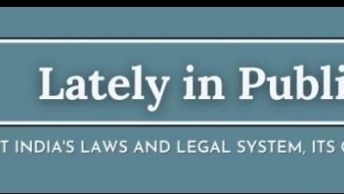Riding the downward tide of the global capital markets, Indian stock prices too tumbled 1,408 points on Monday, January 21, 2008 making investors poorer by $155 billion in a single day. The rout continued on Tuesday as well, before the markets partially recovered towards the end of the week. Reports indicate that investors have lost Rs. 18.05 trillion in 7 days; many of them saw their life-savings being wiped-out while some went bankrupt. The Gujarat police despatched a posse of policemen to secure Ahmedabad’s largest lake – yes, there is a connection – due to the fear of suicides by distraught investors and brokers.
Reasons
Several reasons have been proffered for the Indian stock market crash. First is the fear of a recession in the United States (US) sparked by the subprime crisis, which is expected to have an impact on the global markets. The Economist reports (in the general context of the global crash):
“For some, this merely represents a case of stockmarkets catching up with reality. It is now a year since the subprime crisis first emerged. In that time central banks have cut interest rates, investment banks have announced big write-offs and various rescue packages have been suggested. But the end of the crisis is not yet in sight. Indeed, another leg of the debt crisis may be under way, if problems of monoline debt-insurers (an obscure but important bunch who guarantee the timely repayment of bond principal and interest when the issuer defaults) are not contained. If the American economy is not now in recession, it is close enough not to make a practical difference to sentiment.
For much of past year equity investors knew those salient facts but chose instead to take comfort from three more bullish factors. First was that the Federal Reserve would rescue both the markets and the economy, as it has done so often before. Second, even if the American economy faltered, the rest of the world (particularly Asia) could take up the burden of producing global growth. Third, given the global picture, corporate profits could stay high.
All three assumptions are now coming under question. … An indication of the change in sentiment came when America’s administration announced plans for a fiscal stimulus on Friday. In good times, that would have kick-started a market rally; in the current mood, the package was seen as a sign of desperation.”
The second reason attributed to the Indian stock market’s decline is massive divestment of Indian stocks by hedge funds and foreign institutional investors (FIIs) either to cash in on the previous bull run in the Indian markets or as a result of reallocation of their investment portfolios arising out of the battering they may have taken due to the US subprime crisis and the lack of liquidity. The global movement of capital in and out of countries (including India) may have caused stocks to turn volatile.
The third is tight domestic liquidity position caused by investors blocking their money in large IPO applications such as that of Reliance Power and Emaar MGF.
The fourth is several chinks exposed in the financial markets’ infrastructure. Just to list a few (and these may not be the only ones), stock exchanges required brokers to pay additional margin money amid declining markets, but brokers were unable to do so as payments from their clients were still awaited as cheques take at least 2 days to clear for the brokers to obtain money from their clients. It has been argued that there is a mismatch between the financial market system and the banking system in terms of timing. Some have gone even further and argued that the margin system enforced by SEBI and stock exchanges is itself questionable (see this column by Surjit Bhalla in the Business Standard).
Last, but not the least, is the omnipresent spectre that pervades any stock market crash – the idea of “irrational exuberance” (a phrase said to have been coined by the former chairman of the US Federal Reserve, Alan Greenspan) on the part of investors and overvaluation of stocks which results in a correction of the markets at some point in time. Some see this as the correction of the markets bringing them down to their real levels.
The Debate
Speaking for myself, it may still be early days before blame can be pinpointed on any single person or institutions or groups of them for either triggering off the present crisis or failing to take adequate steps to prevent or mitigate such a crisis. This may require an in-depth study of the turn of events. Unlike certain previous stock market crises (which have been termed “scams”, and appropriately so), there yet appear to be no allegations of shenanigans in any of the market players. Readers will recollect that the 1992 scam was largely attributed to the (mis)conduct of the late Harshad Mehta, while the 2001 scam to broker Ketan Parikh. Those scams did propel the Government to set up Joint Parliamentary Committees (JPC) to investigate the actions of various parties involved in stock market transactions. I am yet to come across either any such allegations of deviousness or any calls for such a JPC in this case.
This episode nevertheless has assumed political proportions. The Government, speaking through the Finance Minister has reiterated that the fundamentals of the Indian economy are strong, and that the market fall is attributable to continuing uncertainties in the global economy. Unsurprisingly, the BJP and the CPI have refused to buy the Government’s argument. The BJP has not only demanded intervention by SEBI, but has also blamed the Finance Ministry and SEBI for allowing overvalued IPOs, not restraining over-speculation and not improving the faulty settlement mechanism. Not to be left behind, the CPI alleges ‘malpractices’ in the stock markets that led to the crash (without further substantiation) and has called for an increase in the securities transaction tax.
All this begs the question: would the existence of a better regulatory system governing markets have prevented the turmoil? Should the financial market regulators (the Finance Ministry, SEBI and RBI) have taken measures to prevent the occurrence of such a crisis? Does this episode demonstrate the need for tighter governmental regulation on financial markets?
Role of Regulation
Since events are still unfolding and we do not have intricate details of acts by market players, and further there is no evidence of egregiousness or fraud, this analysis will necessarily have to be limited to the reasons for the crash as set out earlier in the post. The reasons can be categorized into three types: (i) external shocks (US recession, subprime crisis and sell-down by hedge funds and FIIs), (ii) internal system failures (illiquidity due to large IPOs and failure of markets’ infrastructure), and (iii) irrational exuberance of investors (overvaluation of stocks).
1. External Shocks
This seems the most plausible reason for the crash on the Indian markets. Not only does the crash come in the wake of the subprime crisis and fears of a US recession, it correlates directly with the decline in markets all over the world; it is not as if this was a phenomenon isolated to India. To blame Indian regulators for this would not hold water. It is nothing but the result of globalization and free flow of capital across the world. That naturally leads me to my next point. One important lesson that the Indian financial regulators can learn from this, though, is that “decoupling” of emerging economies (like India and China) from those of the developed economies (like the US and Western European nations) is a myth. Events that occur in one part of the world are bound to have a serious impact in other parts of the world. It seems to me that the turmoil of last week takes a further step in silencing the proponents of the “decoupling” theory. It is important that the Indian financial regulators recognize this while tailoring their policies for the financial markets.
Let us look at the menu of options available to the policy makers. A safe option would be to revert to the protectionist policies that were followed before India embarked on its new economic policy in 1991. While that would effectively insulate India from global volatility, this is not something one would advocate because we are not only far ahead down the path of economic liberalisation but any such stance would lead to India’s economic isolation. The other option would be to let the market control events (and correct itself) and hence impose minimal governmental regulation. But, to embrace dogmatic capitalism and a laissez-faire approach would be counterproductive. The path that the Indian regulators have adopted is somewhat of a midway approach of progressive liberalisation and de-regulation.
India still does have several restrictions on foreign investment, both on the strategic side and the portfolio side. On the portfolio side, which is what the stock markets are largely concerned with, SEBI has prescribed regulations for foreign institutional investors (FIIs) that require FIIs to register with SEBI and also imposes various curbs on their conduct. More recently, SEBI has placed severe restrictions on investments by hedge funds and required them to “come through the front door” (a statement attributable to the SEBI Chairman, Mr. M. Damodaran) rather than investing through the opaque participatory note (PN) structure that they hitherto used. Despite resistance from market players as being a harsh move and the consequent mini-market-crash in October 2007, SEBI did not relent under pressure and persisted with the rule, which became final on October 25, 2007. India is one of the few nations that tightly regulate hedge funds, in as much as this move is constantly pounded with criticism from the western media as indirect strengthening of capital controls on the Indian economy. The reader might well ask: why then was there a sell down in last week’s turmoil purportedly by hedge funds and FIIs that SEBI could not prevent? Perhaps the answer lies in the fact that the revised regulations on hedge funds are not only new, but also have inbuilt time periods (e.g. an 18-month period) for parts of it to come into effect.
While regulators or regulations cannot prevent external shocks altogether, measures can be taken to mitigate its impact.
2. Internal System Failures
While the external shocks seem primarily responsible for causing the markets to tumble, the downfall may have exacerbated by internal system failures. These include settlement-related issues, margin requirements, circuit breakers and other technical matters involved in stock trading and stock exchange operations. This does give rise to the need for introspection – perhaps it is this precise area where regulatory reforms will play a significant role to prevent recurrences. SEBI needs to investigate further to identify the systemic failures in the financial markets and make suitable modifications and corrections to the system with the assistance of financial market experts.
3. Irrational Exuberance
Investors pump money into the stock markets in the expectation that the price of their stock will go up and provide (sometimes quick) returns. But, often stocks are overvalued and investors enter the markets during a boom and then suffer losses when there is a subsequent downfall. The criticism is that investors make investment decisions without regard to the underlying fundamentals of either the company in which they invest or the economy itself. What role can regulation play here, and is there always a failure of regulation when markets go on a downward spiral and cause losses to investors?
At the outset, I find it hard to sympathize with the position that the government should be blamed for all the adverse outcomes (and consequent ill-fortunes) of its citizens’ financial choices. Financial markets are risky indeed, and it is not everyone who plays in that market that can absorb or handle the risk involved. Is it right to ask the government to adopt a paternalistic attitude and protect all investors against such risks? If not, to what extent can investors rely on the government for protection?
There are two types of investors. One consists of the institutional investors, such as FIIs, hedge funds, banks, insurance companies and so on, or individual investors such as high-net worth individuals, who possess a certain level of sophistication – their funds are managed by qualified and experienced investment managers. Such sophisticated investors may require less regulatory protection as they are well aware of the risks of the stock market; they are also well funded and capitalized to absorb shocks.
It is the second type of investors, the men and women on the street (referred to as retail investors) that do not possess knowledge and sophistication when it comes to investment matters, who beseech governmental protection. They often invest their life-savings that sometimes turn into dust, as many of them experienced during last week’s meltdown. While law and regulation cannot hand-hold such investors and protect them from their irrationalities, it can certain equip them and provide them with enough information and knowledge that can help them make rational choices. Regulators lay down disclosure norms that require companies to publish all investment risks in their offer documents.
In the Indian context, the SEBI (Disclosure and Investor Protection) Guidelines, 2000 that have been strengthened over the years, impose strict disclosure norms on companies issuing capital to investors. However, this is applicable only when companies make public offerings (an initial public offering (IPO) or a follow-on public offering (FPO)) or qualified institutional placements (QIP) of shares to investors; these are typically known as primary market transactions. But, once the shares of the company are already traded on the stock exchange, the obligations of companies to make disclosure are much less severe. Hence, a person who buys shares of a listed company on the stock exchange in a secondary market transaction has far less information compared to a person who purchases shares in a public offering. This causes many retail secondary market investors to acquire shares in overvalued stocks during a boom without having understood the fundamentals of the company and the economy. This disparity between disclosures in primary market transactions and secondary market transactions may require correction by SEBI.
Another area to protect individual investors is through investor education. Though SEBI and the Ministry of Company Affairs have initiated several programmes to this end (here is SEBI’s Investor Awareness site) they do not appear to have gathered enough steam. This is an area where regulators can play a far greater role in minimizing the damage caused to investors in case of market turmoil.
Suggestions have been made (by the CPI General Secretary, A. P. Bardhan in particular) that the securities transaction tax (STT) must be heavily hiked from its current rate of 0.1%. It is not clear if this is mere rhetoric or how this proposal will help, as it will still be the individual investors (in addition to the other investors of course) who will have to bear the burden of the additional outgo.
In sum, the recent market turmoil has exposed the need for further regulatory action to safeguard investors in the Indian markets as we have seen above, but it is my belief that commentators are overplaying the scenario and taking it too far by attributing the crisis to regulatory failure. The crises would have occurred anyway, but its blow could have been softened with better regulation.
The ShockGen Effect
On a slightly different note, but still remaining within the confines of financial market regulation, a single trader named Jerome Kerviel belonging to Societe Generale (SocGen) was reported last Thursday to have caused the bank a loss of over €5 billion in the largest ever fraud in the investment banking history. He is said to have far exceed his sanctioned trading limits, manipulated computer records and created elaborate fictitious hedging limits to cover up his scheme, and still managed to remain undetected for almost 10 days despite high levels of compliance controls. Query: will any number of regulators or any amount of regulation have prevented this crisis?





